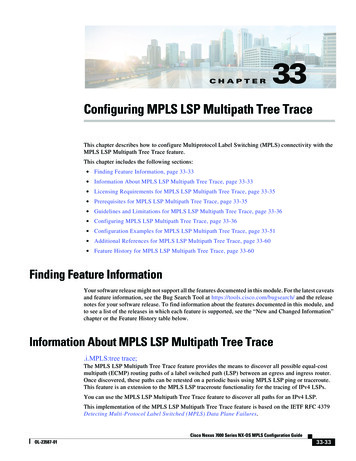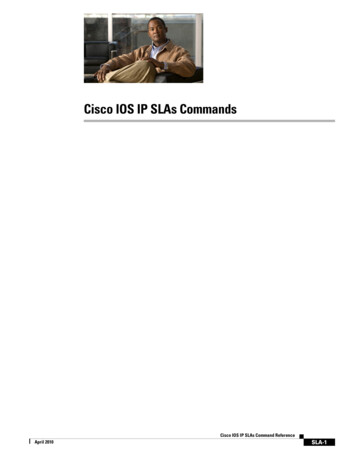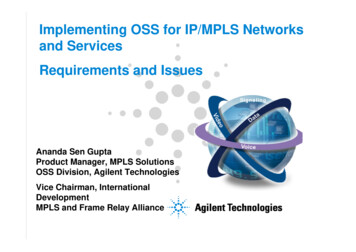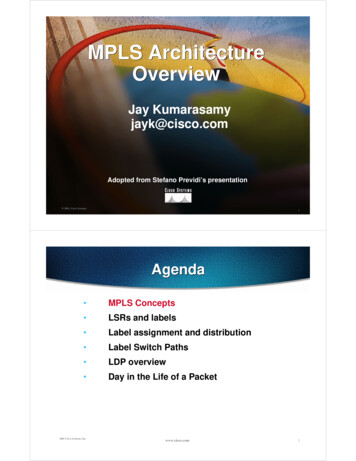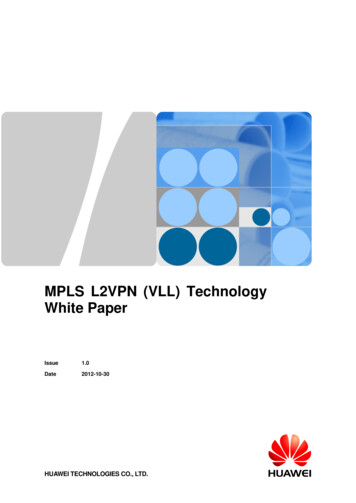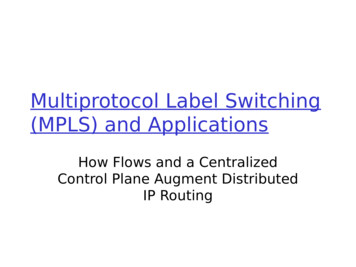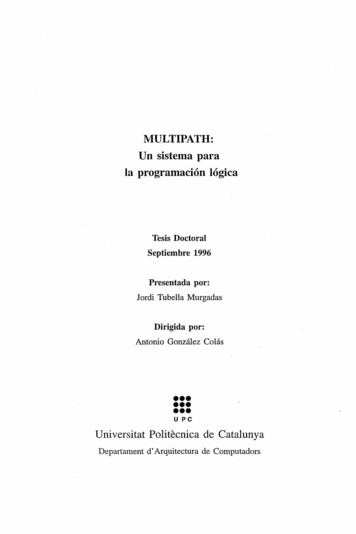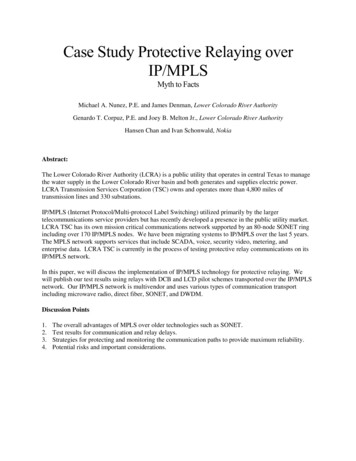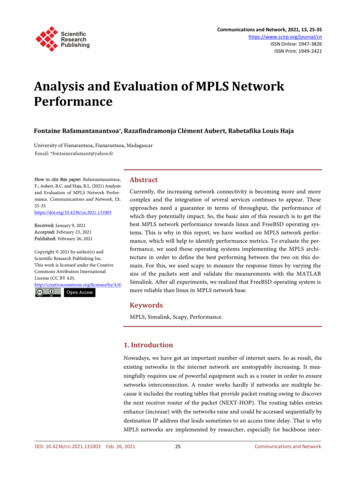
Transcription
MPLS EM—MPLS LSP Multipath Tree TraceFirst Published: December 4, 2006Last Updated: Ferbruay 27, 2009The MPLS EM—MPLS LSP Multipath Tree Trace feature provides the means to discover all possibleequal-cost multipath (ECMP) routing paths of a label switched path (LSP) between an egress and ingressrouter. Once discovered, these paths can be retested on a periodic basis using Multiprotocol LabelSwitching (MPLS) LSP ping or traceroute. This feature is an extension to the MPLS LSP traceroutefunctionality for the tracing of IPv4 LSPs.You can use the MPLS EM—MPLS LSP Multipath Tree Trace feature to discover all paths for an IPv4LSP.This implementation of the MPLS EM—MPLS LSP Multipath Tree Trace feature is based on RFC 4379,Detecting Multi-Protocol Label Switched (MPLS) Data Plane Failures.For information on the use of MPLS LSP ping and traceroute, see the MPLS EmbeddedManagement—LSP Ping/Traceroute and AToM VCCV feature module.Cisco IOS MPLS Embedded Management (EM) is a set of standards and value-added services thatfacilitate the deployment, operation, administration, and management of MPLS-based networksaccording to the fault, configuration, accounting, performance, and security (FCAPS) model.Finding Feature InformationYour software release may not support all the features documented in this module. For the latest featureinformation and caveats, see the release notes for your platform and software release. To find informationabout the features documented in this module, and to see a list of the releases in which each feature issupported, see the “Feature Information for MPLS EM—MPLS LSP Multipath Tree Trace” section onpage 33.Use Cisco Feature Navigator to find information about platform support and Cisco IOS and Catalyst OSsoftware image support. To access Cisco Feature Navigator, go to http://www.cisco.com/go/cfn. Anaccount on Cisco.com is not required.Americas Headquarters:Cisco Systems, Inc., 170 West Tasman Drive, San Jose, CA 95134-1706 USA
MPLS EM—MPLS LSP Multipath Tree TraceContentsContents Prerequisites for MPLS EM—MPLS LSP Multipath Tree Trace, page 2 Restrictions for MPLS EM—MPLS LSP Multipath Tree Trace, page 2 Information About MPLS EM—MPLS LSP Multipath Tree Trace, page 3 How to Configure MPLS EM—MPLS LSP Multipath Tree Trace, page 4 Configuration Examples for MPLS EM—MPLS LSP Multipath Tree Trace, page 22 Additional References, page 31 Command Reference, page 32 Feature Information for MPLS EM—MPLS LSP Multipath Tree Trace, page 33 Glossary, page 35Prerequisites for MPLS EM—MPLS LSP Multipath Tree TraceThe following are prerequisites for using the MPLS EM—MPLS LSP Multipath Tree Trace feature: You must understand the concepts and know how to use MPLS LSP ping or traceroute as describedin the MPLS LSP Ping/Traceroute for LDP/TE, and LSP Ping for VCCV document. The routers in your network must be using an implementation based on RFC 4379, DetectingMulti-Protocol Label Switched (MPLS) Data Plane Failures. You should know the following about your MPLS network:– The topology– The number of links in your network– The expected number of LSPs, and how many LSPs Understand label switching, forwarding, and load balancing.Restrictions for MPLS EM—MPLS LSP Multipath Tree Trace All restrictions that apply to the MPLS LSP Ping and LSP Traceroute features also apply to theMPLS EM—MPLS LSP Multipath Tree Trace feature:– You cannot use the MPLS LSP Multipath Tree Trace feature to trace the path taken by AToMpackets. The MPLS LSP Multipath Tree Trace feature is not supported for AToM. (MPLS LSPPing is supported for AToM.) However, you can use the MPLS LSP Multipath Tree Tracefeature to troubleshoot the Interior Gateway Protocol (IGP) LSP that is used by AToM.– You cannot use the MPLS LSP Multipath Tree Trace feature to validate or trace MPLS VirtualPrivate Networks (VPNs). Multiple LSP paths are not discovered unless all routers in the MPLScore support an RFC 4379 implementation of Detecting Multi-Protocol Label Switched (MPLS)Data Plane Failures. 2MPLS LSP multipath tree trace is not expected to operate in networks that support time-to-live(TTL) hiding.
MPLS EM—MPLS LSP Multipath Tree TraceInformation About MPLS EM—MPLS LSP Multipath Tree TraceInformation About MPLS EM—MPLS LSP Multipath Tree TraceBefore using the MPLS EM—MPLS LSP Multipath Tree Trace feature, you need an understanding ofthe following concepts: Overview of MPLS LSP Multipath Tree Trace, page 3 Discovery of IPv4 Load Balancing Paths by MPLS LSP Multipath Tree Trace, page 3 Echo Reply Return Codes Sent by the Router Processing Multipath LSP Tree Trace, page 4Overview of MPLS LSP Multipath Tree TraceAs the number of MPLS deployments increases, the number of traffic types the MPLS networks carrycould increase. In addition, load balancing on label switch routers (LSRs) in the MPLS network providesalternate paths for carrying MPLS traffic to a target router. The ability of service providers to monitorLSPs and quickly isolate MPLS forwarding problems is critical to their ability to offer services.Prior to the release of the MPLS EM—MPLS LSP Multipath Tree Trace feature no automated wayexisted to discover all paths between provider edge (PE) routers. Troubleshooting forwarding problemsbetween PEs was cumbersome.The release of the MPLS EM—MPLS LSP Multipath Tree Trace feature provides an automated way todiscover all paths from the ingress PE router to the egress PE router in multivendor networks that useIPv4 load balancing at the transit routers. Once the PE-to-PE paths are discovered, use MPLS LSP pingand MPLS LSP traceroute to periodically test them.The MPLS EM—MPLS LSP Multipath Tree Trace feature requires the Cisco RFC-compliantimplementation that is based on RFC 4379. If you do not have a Cisco IOS release that supportsRFC 379, MPLS LSP multipath tree trace does not operate to discover all PE-to-PE paths.Discovery of IPv4 Load Balancing Paths by MPLS LSP Multipath Tree TraceIPv4 load balancing at a transit router is based on the incoming label stack and the source and destinationaddresses in the IP header. The outgoing label stack and IP header source address remain constant foreach branch being traced.When you execute MPLS LSP multipath tree trace on the source LSR, the router needs to find the set ofIP header destination addresses to use all possible output paths. The source LSR starts path discovery bysending a transit router a bitmap in an MPLS echo request. The transit router returns information in anMPLS echo request that contains subsets of the bitmap in a downstream map (DS Map) in an echo reply.The source router can then use the information in the echo reply to interrogate the next router. The sourcerouter interrogates each successive router until it finds one bitmap setting that is common to all routersalong the path. The router uses TTL expiry to interrogate the routers to find the common bits.For example, you could start path discovery by entering the following command at the source router:Router# trace mpls multipath ipv4 10.131.101.129/32 hashkey ipv4 bitmap 16This command sets the IP address of the target router as 10.131.101.192 255.255.255.255 andconfigures: The default hash key type to 8, which requests that an IPv4 address prefix and bit mask address setbe returned in the DS Map in the echo reply.3
MPLS EM—MPLS LSP Multipath Tree TraceHow to Configure MPLS EM—MPLS LSP Multipath Tree Trace The bitmap size to 16. This means that MPLS LSP multipath tree trace uses 16 addresses (startingwith 127.0.0.1) in the discovery of all paths of an LSP between the source router and the targetrouter.If you enter the trace mpls multipath ipv4 10.131.101.129/32 command, MPLS LSP multipath treetrace uses the default hash type of 8 or IPv4 and a default bitmap size of 32. Your choice of a bitmap sizedepends on the number of routes in your network. If you have a large number of routes, you might needto use a larger bitmap size.Echo Reply Return Codes Sent by the Router Processing Multipath LSP TreeTraceTable 1 describes the characters that the router processing a multipath LSP tree trace packet returns tothe sender about the failure or success of the request.Table 1Echo Reply Return CodesOutput CodeEcho ReturnCodeMeaningPeriod “.”—A timeout occurred before the target router could reply.x0No return code.M1Malformed request.m2Unsupported type, length, values (TLVs).!3Success.F4No Forwarding Equivalence Class (FEC) mapping.D5DS Map mismatch.R6Downstream router but not target.U7Reserved.L8Labeled output interface.B9Unlabeled output interface.f10FEC mismatch.N11No label entry.P12No receive interface label protocol.p13Premature termination of the LSP.XunknownUndefined return code.How to Configure MPLS EM—MPLS LSP Multipath Tree TraceThis section contains the following tasks:4 Customizing the Default Behavior of MPLS Echo Packets, page 5 (optional) Configuring MPLS LSP Multipath Tree Trace, page 7 (required) Discovering IPv4 Load Balancing Paths Using MPLS LSP Multipath Tree Trace, page 9 (required)
MPLS EM—MPLS LSP Multipath Tree TraceHow to Configure MPLS EM—MPLS LSP Multipath Tree Trace Monitoring LSP Paths Discovered by MPLS LSP Multipath Tree Trace Using MPLS LSPTraceroute, page 10 (optional) Using DSCP to Request a Specific Class of Service in an Echo Reply, page 13 (optional) Controlling How a Responding Router Replies to an MPLS Echo Request, page 14 (optional) Specifying the Output Interface for Echo Packets Leaving a Router for MPLS LSP Multipath TreeTrace, page 16 (optional) Setting the Pace of MPLS Echo Request Packet Transmission for MPLS LSP Multipath Tree Trace,page 17 (optional) Enabling MPLS LSP Multipath Tree Trace to Detect LSP Breakages Caused by an Interface ThatLacks an MPLS Configuration, page 18 (optional) Requesting That a Transit Router Validate the Target FEC Stack for MPLS LSP Multipath TreeTrace, page 19 (optional) Setting the Number of Timeout Attempts for MPLS LSP Multipath Tree Trace, page 21 (optional)Customizing the Default Behavior of MPLS Echo PacketsPerform the following task to customize the default behavior of MPLS echo packets. You might need tocustomize the default echo packet encoding and decoding behavior to allow later implementations of theDetecting MPLS Data Plane Failures (RFC 4379) to be deployed in networks running earlier versionsof the draft.MPLS Embedded Management ConfigurationBefore using the ping mpls, trace mpls, or trace mpls multipath command, you should considerensuring that the router is configured to encode and decode MPLS echo packets in a format that allreceiving routers in the network can understand.LSP ping drafts after Version 3 (draft-ietf-mpls-ping-03) have undergone numerous TLV formatchanges, but the implementations based on different drafts might not interoperate properly.To allow later Cisco implementations to interoperate with draft Version 3 Cisco and non-Ciscoimplementations, a global configuration mode (MPLS OAM configuration) allows you to encode anddecode echo packets in formats specified by draft Version 3 implementations.Unless configured otherwise, a Cisco implementation encodes and decodes echo requests assuming theversion on which the Internet Engineering Task Force (IETF) implementation is based.To allow for seamless interoperability with earlier Revision 1 and 3 images, you can use MPLSOperation, Administration, and Maintenance (OAM) configuration mode parameters to force the defaultbehavior of the Revision 4 images to be compliant or compatible in networks with Revision 1 or Revision3 images.To prevent failures reported by the replying router due to TLV version issues, you should configure allrouters in the core. Encode and decode MPLS echo packets in the same draft version. For example, ifthe network is running RFC 4379 (Cisco Revision 4) implementations but one router is capable of onlyVersion 3 (Cisco Revision 3), configure all routers in the network to operate in Revision 3 mode.Cisco Revision 4 is the default version. The default version is the latest LSP Ping version supported bythe image on the router.5
MPLS EM—MPLS LSP Multipath Tree TraceHow to Configure MPLS EM—MPLS LSP Multipath Tree TracePrerequisitesMPLS LSP Multipath Tree Trace requires RFC 4379 (Revision 4).SUMMARY STEPS1.enable2.configure terminal3.mpls oam4.echo revision {3 4}5.[no] echo vendor-extension6.endDETAILED STEPSStep 1Command or ActionPurposeenableEnables privileged EXEC mode. Enter your password if prompted.Example:Router enableStep 2configure terminalEnters global configuration mode.Example:Router# configure terminalStep 3mpls oamEnters MPLS OAM configuration mode and customizes thedefault behavior of echo packets.Example:Router(config)# mpls oamStep 4echo revision {3 4}Customizes the default behavior of echo packets. Example:Router(config-mpls)# echo revision 4The revision keyword set echo packet attributes to oneof the following:– 3 draft-ietf-mpls-ping-03 (Revision 2)– 4 RFC 4379 compliant (default)Note6The MPLS LSP Multipath Tree Trace featurerequires Revision 4.
MPLS EM—MPLS LSP Multipath Tree TraceHow to Configure MPLS EM—MPLS LSP Multipath Tree TraceStep 5Command or ActionPurpose[no] echo vendor-extensionCustomizes the default behavior of echo packets. The vendor-extension keyword sends theCisco-specific extension of TLVs with the echopackets. The no form of the command allows you to disable aCisco vendor’s extension TLVs that another vendor’snoncompliant implementations may not support.Example:Router(config-mpls)# echo vendor-extensionThe router default is echo vendor-extension.Step 6Exits to privileged EXEC mode.endExample:Router(config-mpls)# endConfiguring MPLS LSP Multipath Tree TracePerform the following task to configure MPLS multipath LSP traceroute. This task helps discover allLSPs from an egress router to an ingress router.PrerequisitesCisco LSP ping or traceroute implementations based on draft-ietf-mpls-lsp-ping-11 are capable in somecases of detecting the formatting of the sender of an MPLS echo request. However, certain cases exist inwhich an echo request or echo reply might not contain the Cisco extension TLV. To avoid complicationsdue to certain cases where the echo packets are decoded assuming the wrong TLV formats, configure allrouters in the network to operate in the same mode.For an MPLS LSP multipath tree trace to be successful, the implementation in your routers must supportRFC 4379 on all core routers.If all routers in the network support FRC-4379 and another vendor’s implementation exists that is notcapable of properly handling Cisco’s vendor TLV, the routers supporting the RFC-compliant or laterconfiguration must include commands to disable the Cisco vendor TLV extensions.SUMMARY STEPS1.enable2.configure terminal3.mpls oam4.echo revision 45.[no] echo vendor-extension6.end7.trace mpls multipath ipv4 bug mpls lspv multipath7
MPLS EM—MPLS LSP Multipath Tree TraceHow to Configure MPLS EM—MPLS LSP Multipath Tree TraceDETAILED STEPSStep 1Command or ActionPurposeenableEnables privileged EXEC mode. Enter your password if prompted.Example:Router enableStep 2configure terminalEnters global configuration mode.Example:Router# configure terminalStep 3mpls oamEnters MPLS OAM configuration mode.Example:Router(config)# mpls oamStep 4echo revision 4Customizes the default behavior of echo packets. Example:Router(config-mpls)# echo revision 4Step 5[no] echo vendor-extensionNoteThe revision 4 keywords set echo packet attributes tothe default Revision 4 (RFC 4379 compliant).The MPLS LSP Multipath Tree Trace featurerequires Revision 4.(Optional) Customizes the default behavior of echo packets. The vendor-extension keyword sends theCisco-specific extension of TLVs with the echopackets. The no form of the command allows you to disable aCisco vendor’s extension TLVs that another vendor’snoncompliant implementations may not support.Example:Router(config-mpls) echo vendor-extensionThe router default is echo vendor-extension.Step 6endExits to privileged EXEC mode.Example:Router(config-mpls)# endStep 7trace mpls multipath Discovers all LSPs from an egress router to an ingressrouter. The ipv4 keyword specifies the destination type as anLDP IPv4 address. The destination-ip-address argument is the addressprefix of the target to be tested. The destination-mask-length argument is the number ofbits in the network mask of the target address. The/ keyword before this argument is required.Example:Router# trace mpls multipath ipv410.131.161.251/32Step 8debug mpls lspv multipathExample:Router# debug mpls lspv multipath8Displays multipath information related to the MPLS LSPMultipath Tree Trace feature.
MPLS EM—MPLS LSP Multipath Tree TraceHow to Configure MPLS EM—MPLS LSP Multipath Tree TraceDiscovering IPv4 Load Balancing Paths Using MPLS LSP Multipath Tree TracePerform the following task to discover IPv4 load balancing paths using MPLS LSP multipath tree trace.MPLS Multipath LSP Traceroute Path DiscoveryA Cisco router load balances MPLS packets based on the incoming label stack and the source anddestination addresses in the IP header. The outgoing label stack and IP header source address remainconstant for each path being traced. The router needs to find the set of IP header destination addressesto use all possible output paths. This might require exhaustive searching of the 127.x.y.z/8 address space.Once you discover all paths from the source LSR to the target or destination LSR with MPLS LSPmultipath tree trace, you can use MPLS LSP traceroute to monitor these paths.Figure 1 shows how MPLS LSP multipath tree trace discovers LSP paths in a sample network. InFigure 1, the bitmap size is 16 and the numbers 0 to 15 represent the bitmapped addresses that MPLSLSP multipath tree trace uses to discover all the paths from the source LSR R-101 to the target LSRR-150. Figure 1 illustrates how the trace mpls multipath command discovers all LSP paths in thesample network.Figure 1MPLS LSP Multipath Tree Trace Path Discovery in a Sample NetworkR-120Address: 1, 2,4, 15R-131 Address: 1, 4Address: 1, 2, 3, 4,5, 7, 13, 15R-141Address: 4Address: 2, 15Address: 3, 5, 7, 13R-130Target R-150R-140Address: 15R-111Address 7, 13SourceSource R-101R-101Address 7Address: 14Address: 0, 6, 8, 9,10, 11, 12, 14R-121 Address: 6, 9,12, 14R-132170601Address: 6, 9, 14SUMMARY STEPS1.enable2.configure terminal3.mpls oam4.echo revision 45.end6.trace mpls multipath ipv4 destination-ip-address/destination-mask-length hashkey ipv4 bitmapbitmap-size9
MPLS EM—MPLS LSP Multipath Tree TraceHow to Configure MPLS EM—MPLS LSP Multipath Tree TraceDETAILED STEPSStep 1Command or ActionPurposeenableEnables privileged EXEC mode. Enter your password if prompted.Example:Router enableStep 2configure terminalEnters global configuration mode.Example:Router# configure terminalStep 3Enters MPLS OAM configuration mode and sets the echopacket attribute to Revision 4 (RFC 4379 compliant).mpls oamExample:Router(config)# mpls oamStep 4echo revision 4Customizes the default behavior of echo packets. Example:Router(config-mpls)# echo revision 4Step 5NoteThe revision 4 keywords set echo packet attributes tothe default Revision 4 (RFC 4379 compliant).The MPLS LSP Multipath Tree Trace featurerequires Revision 4.Exits to privileged EXEC mode.endExample:Router(config-mpls)# endStep 6trace mpls multipath ipv4 destination-address/destination-mask-length hashkey ipv4 bitmapbitmap-sizeExample:Router# trace mpls multipath ipv410.131.161.251/32 hashkey ipv4 bitmap 16Discovers all MPLS LSPs from an egress router to aningress router. The ipv4 keyword specifies the destination type as anLDP IPv4 address. The destination-address argument is the address prefixof the target to be tested. The destination-mask-length argument is the number ofbits in the network mask of the target address. The/ keyword before this argument is required. The hashkey ipv4 keywords set the hashkey type toIPv4 addresses. The bitmap bitmap-size keyword and arguments set thebitmap size for multipath discovery.Monitoring LSP Paths Discovered by MPLS LSP Multipath Tree Trace UsingMPLS LSP TraceroutePerform the following task to monitor LSP paths discovered by MPLS LSP multipath tree trace usingMPLS LSP traceroute. You can take output directly from the trace mpls multipath command and addit to a trace mpls command periodically to verify that the path is still operating.10
MPLS EM—MPLS LSP Multipath Tree TraceHow to Configure MPLS EM—MPLS LSP Multipath Tree TraceFigure 2 shows the mapping of the output of a trace mpls multipath command to a trace mplscommand.Figure 2Mapping of trace mpls multipath Command Output to a trace mpls CommandRouter# trace mpls multipath ipv4 10.1.1.150/32 hashkey ipv4 bitmap 16output interface Et0/0source 10.1.111.101destination 127.0.0.7Router# trace mpls ipv4 10.1.1.1.150/32 output interface Et0/0 source 10.1.111.101destination 127.0.0.7170602trace mpls {ipv4 destination -add res s/destina tion-mask [destinatio n ad dres s-start [ad dres s-end][address-incremen t]] traffic-eng tu nnel-interface tu nnel-number} [revis ion {1 2 3 4}][so urce source-ad dress] [timeout seconds] [reply dscp dscp-va lu e] [reply pad-tlv][reply mode reply-mo de] [ttl ma ximum-time-to-live] [exp exp-bits] [revisiontlv-revision -nu mber] [force-ex plicit-null] [output interface tx-interface] [fla gs fec]Each path you discover with MPLS LSP Multipath Tree Trace can be tested in this manner periodicallyto monitor the LSP paths in your network.SUMMARY STEPS1.enable2.trace mpls multipath ipv4 destination-address/destination-mask-length hashkey ipv4 bitmapbitmap-size3.trace mpls ipv4 destination-address/destination-mask-length [output interface tx-interface][source source-address] [destination address-start]4.exitDETAILED STEPSStep 1enableUse this command to enable privileged EXEC mode. Enter your password if prompted. For example:Router enableRouter#Step 2trace mpls multipath ipv4 destination-address/destination-mask-length hashkey ipv4 bitmapbitmap-sizeUse this command to discover all MPLS LSPs from an egress router to an ingress router. For example:Router# trace mpls multipath ipv4 10.1.1.150/32 hashkey ipv4 bitmap 16Starting LSP Multipath Traceroute for 10.1.1.150/32Codes: '!' - success, 'Q' - request not sent, '.' - timeout,'L' - labeled output interface, 'B' - unlabeled output interface,'D' - DS Map mismatch, 'F' - no FEC mapping, 'f' - FEC mismatch,'M' - malformed request, 'm' - unsupported tlvs, 'N' - no label entry,'P' - no rx intf label prot, 'p' - premature termination of LSP,11
MPLS EM—MPLS LSP Multipath Tree TraceHow to Configure MPLS EM—MPLS LSP Multipath Tree Trace'R' - transit router, 'I' - unknown upstream index,'X' - unknown return code, 'x' - return code 0Type escape sequence toLLLL!Path 0 found,output interface Et0/0LLL!Path 1 found,output interface Et0/0L!Path 2 found,output interface Et0/0LL!Path 3 found,output interface Et0/0abort.source 10.1.111.101 destination 127.0.0.0source 10.1.111.101 destination 127.0.0.1source 10.1.111.101 destination 127.0.0.5source 10.1.111.101 destination 127.0.0.7Paths (found/broken/unexplored) (4/0/0)Echo Request (sent/fail) (14/0)Echo Reply (received/timeout) (14/0)Total Time Elapsed 468 msThe output of the trace mpls multipath command in the example shows the result of path discoverywith MPLS LSP multipath tree trace. In this example, the command sets the bitmap size to 16. Pathdiscovery starts by MPLS LSP multipath tree trace using 16 bitmapped addresses as it locates LSP pathsfrom the source router to the target router with prefix and mask 10.1.1.150/32. MPLS LSP multipath treetrace starts using the 127.x.y.z/8 address space with 127.0.0.1.Step 3trace mpls ipv4 destination-address/destination-mask-length [output interface tx-interface] [sourcesource-address] [destination address-start]Use this command to verify that the paths discovered when you entered a trace mpls multipathcommand are still operating. For example, the output for Path 0 in the previous trace mpls multipathcommand in Step 2 is:output interface Et0/0 source 10.1.111.101 destination 127.0.0.0If you put the output for path 0 in the trace mpls command, you see the following results:Router# trace mpls ipv4 10.1.1.150/32 output interface Et0/0 source 10.1.111.101destination 127.0.0.0Tracing MPLS Label Switched Path to 10.1.1.150/32, timeout is 2 secondsCodes: '!' - success, 'Q' - request not sent, '.' - timeout,'L' - labeled output interface, 'B' - unlabeled output interface,'D' - DS Map mismatch, 'F' - no FEC mapping, 'f' - FEC mismatch,'M' - malformed request, 'm' - unsupported tlvs, 'N' - no label entry,'P' - no rx intf label prot, 'p' - premature termination of LSP,'R' - transit router, 'I' - unknown upstream index,'X' - unknown return code, 'x' - return code 0Type escape sequence to abort.0 10.1.111.101 MRU 1500 [Labels:L 1 10.1.111.111 MRU 1500 [Labels:L 2 10.2.121.121 MRU 1500 [Labels:L 3 10.3.132.132 MRU 1500 [Labels:L 4 10.4.140.240 MRU 1504 [Labels:! 5 10.5.150.50 20 ms33 Exp: 0]34 Exp: 0] 4034 Exp: 0] 3232 Exp: 0] 16implicit-nullmsmsmsExp: 0] 20 msYou can take output directly from the trace mpls multipath command and add it to a trace mplscommand periodically to verify that the path is still operating (see Figure 2).12
MPLS EM—MPLS LSP Multipath Tree TraceHow to Configure MPLS EM—MPLS LSP Multipath Tree TraceStep 4exitUse this command to exit to user EXEC mode. for example:Router# exitRouter Using DSCP to Request a Specific Class of Service in an Echo ReplyFor Cisco IOS Release 12.2(27)SXE, Cisco added a reply differentiated services code point (DSCP)option that lets you request a specific class of service (CoS) in an echo reply.The reply DSCP option is supported in the experimental mode for IETF draft-ietf-mpls-lsp-ping-03.txt.Cisco implemented a vendor-specific extension for the reply DSCP option rather than using a Reply TOSTLV. A Reply TOS TLV serves the same purpose as the reply dscp command in IETFdraft-ietf-mpls-lsp-ping-11.txt. This draft provides a standardized method of controlling the reply DSCP.NoteBefore RFC 4379, Cisco implemented the Reply DSCP option as an experimental capability using aCisco vendor extension TLV. If a router is configured to encode MPLS echo packets for draft Version 3implementations, a Cisco vendor extension TLV is used instead of the Reply TOS TLV that wasdefined in draft Version 8.To use DSCP to request a specific CoS in an echo reply, perform the following steps.SUMMARY STEPS1.enable2.trace mpls multipath ipv4 destination-address/destination-mask-length [reply dscp dscp-value]3.exit13
MPLS EM—MPLS LSP Multipath Tree TraceHow to Configure MPLS EM—MPLS LSP Multipath Tree TraceDETAILED STEPSStep 1Command or ActionPurposeenableEnables privileged EXEC mode. Enter your password if prompted.Example:Router enableStep 2trace mpls multipath ipv4 destination-address/destination-mask-length [reply dscp dscp-value]Discovers all MPLS LSPs from an ingress router to anegress router and controls the DSCP value of an echo reply. The ipv4 keyword specifies the destination type as anLDP IPv4 address. The destination-address argument is the address prefixof the target to be tested. The destination-mask-length argument is the number ofbits in the network mask of the target address. The/ keyword before this argument is required. The reply dscp dscp-value keywords and argument arethe DSCP value of an echo reply. A Reply TOS TLVserves the same purpose as the reply dscp command inIETF draft-ietf-mpls-lsp-ping-11.txt.Example:Router# trace mpls multipath ipv410.131.191.252/32 reply dscp 50NoteStep 3To specify a DSCP value, you must enter the replydscp dscp-value keywords and argument.Returns to user EXEC mode.exitExample:Router# exitControlling How a Responding Router Replies to an MPLS Echo RequestThis section contains information about and instructions for controlling how a responding router repliesto an MPLS echo request. You should understand the following information before you configure a replymode for the echo request response: Reply Modes for an MPLS LSP Multipath Tree Trace Echo Request Response, page 14Reply Modes for an MPLS LSP Multipath Tree Trace Echo Request ResponseThe reply mode controls how a responding router replies to an MPLS echo request sent by a trace mplsmultipath command. There are two reply modes for an echo request packet:Note14 ipv4—Reply with an IPv4 User Datagram Protocol (UDP) packet (default) router-alert—Reply with an IPv4 UDP packet with router alertUse the ipv4 and router-alert reply modes with each other to prevent false negatives. If you do not receivea reply via the ipv4 mode, send a test with the router-alert reply mode. If both fail, something is wrongin the return path. The problem might be due to an incorrect ToS setting.
MPLS EM—MPLS LSP Multipath Tree TraceHow to Configure MPLS EM—MPLS LSP Multipath Tree TraceIPv4 UDP Reply ModeThe IPv4 UDP reply mode is the most common reply mode used with a trace mpls multipath commandwhen you want to periodically poll the integrity of an LSP. With this option, you do not have explicitcontrol over whether the packet traverses IP or MPLS hops to reach the originator of the MPLS echorequest. If the originating (headend) router fails to receive a reply to an MPLS echo request when youuse the reply mode ipv4 keywords, use the reply mode router-alert keywords.Router-alert Reply ModeThe router-alert reply mode adds the router alert option to the IP header. When an IP packet that containsan IP router alert option in its IP header or an MPLS packet with a router alert label as its outermost labelarrives at a router, the router punts (redirects) the packet to the Route Processor (RP) process level forhandling. This forces the RP of each intermediate router to specifically handle the packet at eachintermediate hop as it moves back to th
Switching (MPLS) LSP ping or traceroute. This feature is an extension to the MPLS LSP traceroute functionality for the tracing of IPv4 LSPs. You can use the MPLS EM—MPLS LSP Multipath Tree Tr ace feature to discover all paths for an IPv4 LSP. . Your software release may not support all the features documented in this module. For the latest .
